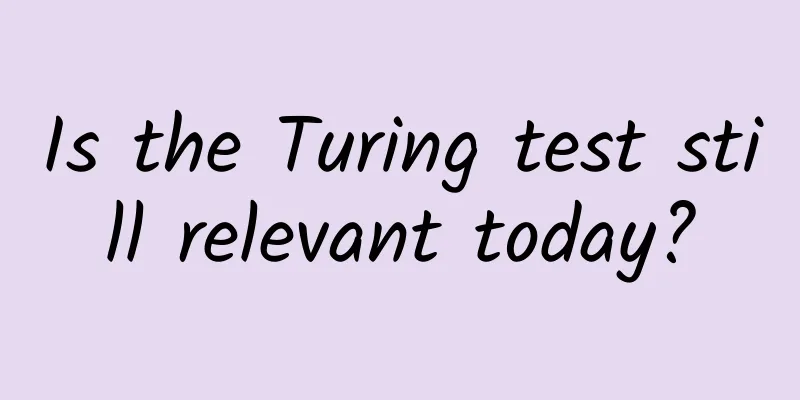Is the Turing test still relevant today?

|
Source: Dark Matter Articles/medium *This article only represents the author's views We must admit that many intermediate states of a machine's operation cannot be foreseen when the initial instructions are designed. The machine itself will also comprehend a lot of knowledge. In this case, it is necessary for us to regard the machine as intelligent. —Alan Turing (Source: Pixabay) The Turing test was proposed by Alan Turing, the father of artificial intelligence. It refers to the tester and the testee (a person and a machine) being separated, and asking random questions to the testee through some devices (such as a keyboard). After multiple tests, if the machine makes each participant make more than 30% misjudgments on average, then the machine passes the test and is considered to have human intelligence. However, AI has evolved dramatically since 1950. So how would today’s AI fare against the Turing test? Is this testing method still useful? Can machines think? Alan Turing was a brilliant scientist who put science above all else throughout his life. He was interested in new technologies and wanted computers to become increasingly intelligent. He also spent a lot of time studying algorithms, complex computer systems, and artificial intelligence. In the case of artificial intelligence, Turing carefully studied the development of artificial intelligence machines and the questions that other scientists asked of intelligent machines. It was in this way that he asked the question "Can machines think?" To find a solution to this problem, Turing tried to find a way to see if a computer could actually speak natural language, becoming like a real person and making it impossible for humans to detect the difference. Figure | Turing in his youth He described the idea in a 1950 paper titled “Computing Machinery and Intelligence,” in which he described an experiment that required three parties: a judge, a woman, and a man. The rules of the game are that the judge needs to determine who is the man and who is the woman. In this case, the goal of the man is to deceive the judge, while the woman can try to help the judge. To be fair, no verbal prompts can be used, only printed questions and answers can be sent back and forth. The question becomes: How does the interrogator know who to trust? Then, Turing began to think about what would happen if one of the people was turned into a computer? How would the judge tell who was human and who was computer? If a tester asked the same series of questions to two objects whose identities could not be confirmed (a person and a machine), and the answers obtained could not distinguish who was the machine and who was the person, then the machine would be considered to have passed the test. Turing also believed that computers would be able to pass this test around the year 2000. However, Turing's prediction did not come true. It wasn’t until 2014 that a chatbot project called Eugene Guzman simulated a 13-year-old Ukrainian boy and passed the Turing test at an event organized by the University of Reading. Although the chatbot convinced 33% of the judges of the Royal Society of London that it was human, critics were quick to point out the shortcomings of the test. Is the Turing test still relevant today? As we wrote above, it is not entirely easy for robots to successfully pass the Turing test today. On the other hand, there is also a group of scientists who believe that this is unfair to machines. This is mainly because many AIs today can be intelligent even without the ability to speak. (Source: Pixabay) In many cases, we associate intelligent machines with robots. But this is not the case. Machines that are not like humans do not mean they are not intelligent. In recent years, many achievements of artificial intelligence can prove this, for example, the first laparoscopic surgery system that does not require human assistance. After all, the Turing test only considers the situation of text communication, but does not take into account that today's artificial intelligence is able to use various sensors to perceive the outside world from multiple angles such as vision, hearing, and touch. For example, Rohit Prasad, vice president of Amazon and chief scientist of voice assistant Alexa, once published an article saying that the Turing test has lost its meaning and it is time to establish a new standard for measuring artificial intelligence. Prasad believes that the goal of the Turing test is not completely consistent with the current direction of artificial intelligence research, and artificial intelligence researchers are not very interested in passing the Turing test. Artificial intelligence is more useful when it is implanted in mobile phones, cars and home appliances. People are more concerned about what new interactive experiences and technological advances AI can bring, rather than whether machines can think like humans. (Source: Pixabay) For example, in the fields of vision and natural language processing in modern artificial intelligence, the most powerful algorithms have achieved results far beyond human performance. For example, AlphaGo defeated the top human Go players, but this achievement is difficult to be reflected in the unchanging Turing test. For this reason, from an application perspective, there is really no need for computers to give up their computing advantages and deliberately simulate humans in order to pass the Turing test. We also have to consider that Turing published his ideas more than 70 years ago, in 1950. In that time, the world of machines has changed a lot. If Turing were still alive, he would probably have a completely different view. However, this does not change the fact that the impact of artificial intelligence on human society has gone beyond the scope of the Turing test. The goal of artificial intelligence research is no longer limited to the difference between AI and humans, but how to give full play to the speed and information search advantages of machines to replace humans to complete work or improve people's daily lives. Sources: https://medium.com/@darkmatterarticles/turing-test-how-does-artificial-intelligence-handle-it-4e439920b69 https://mp.weixin.qq.com/s/-_lmbjhLAyMMKmhZ9Hu0RA Academic headlines |
<<: Torchbearers at the Paralympics and their robotic arms and legs
Recommend
The product is still in the development stage, what operations must do?
Many people say that products come first and oper...
Search traffic has decreased, social traffic has doubled, how to grasp the app operation?
Trend: Search traffic declines, social traffic do...
It is becoming increasingly difficult to flash a mobile phone. What should Android users do?
Since the birth of Android phones, flashing has a...
The reason why Android is lagging more than iOS has been found: it uses nearly 3 times more memory
When we mention Android and iOS, many people'...
The body sends out signals when you are aging. Check yourself! The key to brain longevity is to look at…
Experts in this article: Wang Gang, Chief Physici...
Android wants to do business with iOS users? They even changed the interaction!
I have introduced to you before that Android 9 is...
Gree Electric Appliances' Dong Mingzhu's successor remains a mystery
Although all kinds of chances and coincidences pu...
IQIYI's Ma Dong: Pirated video websites are doomed to fail
On September 16, at the International Copyright F...
From getting started to giving up, an article reviews the history of Google tablets
After nine years of ups and downs, Google finally...
QQShare: How did an unknown app in China become a national app in India?
[[167125]] In China, not many people know Yan Fei...
Is postpartum depression just pretentious?
This is the 4672nd article of Da Yi Xiao Hu After...
Just now, complete success!
Expert of this article: Lin Wenjie, engineer, sen...
Don’t ignore your parents’ leg pain. Many people suffer from it when they are older! Keep doing this to protect your joints
My parents are getting old, climbing the stairs W...
Will artificial intelligence replace humans? Don't worry, you're overthinking it
TechCrunch, a US technology website, wrote an arti...
What is a community? How should it be operated?
1. Everyone is chatting in the community Everyone...









